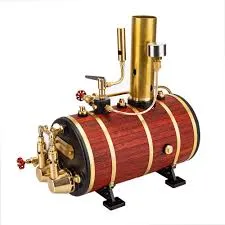
Dec . 21, 2024 19:06 Back to list
commercial oil fired steam boiler
Understanding Commercial Oil-Fired Steam Boilers
In industrial and commercial settings, efficiency, reliability, and cost-effectiveness are paramount. One of the primary systems used to meet heating and energy needs is the oil-fired steam boiler. These boilers are designed to harness the energy stored in oil, converting it into steam for various applications, including heating, power generation, and process steam.
Oil-fired steam boilers operate on a relatively straightforward principle. Oil is burned in a combustion chamber, creating hot gases, which pass through a heat exchanger. The heat from these gases is then transferred to water, converting it to steam. This steam can then be used for heating purposes or to drive turbines for electricity generation.
Efficiency and Performance
One of the key advantages of oil-fired steam boilers is their high efficiency. Modern designs offer thermal efficiencies of up to 90% or more, allowing businesses to reduce fuel consumption while maximizing output. This efficiency is particularly important as fuel prices continue to fluctuate, and energy costs rise.
Additionally, oil-fired steam boilers are known for their reliability and longevity. With proper maintenance, these systems can last for many years, providing consistent performance even under demanding conditions. This durability makes them a popular choice in various sectors, including healthcare, manufacturing, and food processing.
Types of Oil-Fired Steam Boilers
There are primarily two types of oil-fired steam boilers fire-tube and water-tube boilers
.1. Fire-Tube Boilers In fire-tube boilers, hot gases from the combustion of oil flow through tubes immersed in water. The heat from the gases transfers to the water, creating steam. Fire-tube boilers are typically easier to maintain and operate, making them suitable for smaller applications.
commercial oil fired steam boiler

2. Water-Tube Boilers In water-tube boilers, water circulates inside tubes that are heated by external combustion gases. This design can operate at higher pressures and is more efficient than fire-tube models, making it suitable for larger scale applications requiring high steam output.
Environmental Considerations
While oil-fired steam boilers offer numerous benefits, there are environmental considerations that need to be addressed. The burning of oil can release carbon dioxide and other pollutants into the atmosphere. To mitigate these impacts, many manufacturers are introducing models that comply with stricter emissions regulations. Advanced combustion technologies and pollution control systems can significantly reduce emissions, making oil-fired boilers a more sustainable option.
Additionally, businesses are increasingly looking at alternative and renewable fuels to decrease their carbon footprint. Biofuels, for instance, can often be used in existing oil-fired steam boiler systems with little modification, allowing companies to transition towards more sustainable energy sources without substantial capital investment.
Maintenance and Safety
Proper maintenance is crucial for ensuring the efficiency and longevity of oil-fired steam boilers. Regular inspections, cleaning, and servicing can prevent breakdowns and ensure safe operation. Safety is particularly important as oil systems can pose risks, including fire hazards and carbon monoxide production. Therefore, employing trained professionals for installation and maintenance is crucial to ensure adherence to safety standards.
Conclusion
In summary, commercial oil-fired steam boilers are a reliable and efficient solution for meeting heating and energy demands in various industries. With modern advancements in technology and a focus on environmental sustainability, these systems continue to evolve, offering businesses flexible and effective solutions for their heating needs. As energy demands grow and regulations tighten, the role of oil-fired steam boilers will likely remain significant, especially when integrated with cleaner technologies and fuel alternatives. Enterprises considering energy solutions should carefully evaluate the benefits and responsibilities associated with oil-fired steam boilers to ensure they meet their operational and environmental goals effectively.
-
High-Efficiency Commercial Oil Fired Steam Boiler for Industry
NewsJul.30,2025
-
High-Efficiency Biomass Fired Thermal Oil Boiler Solutions
NewsJul.30,2025
-
High Efficiency Gas Fired Thermal Oil Boiler for Industrial Heating
NewsJul.29,2025
-
High-Efficiency Gas Fired Hot Water Boiler for Sale – Reliable & Affordable
NewsJul.29,2025
-
High Efficiency Biomass Fired Hot Water Boiler for Industrial and Commercial Use
NewsJul.29,2025
-
High-Efficiency Biomass Fired Hot Water Boiler for Industrial Use
NewsJul.28,2025
Related PRODUCTS






















